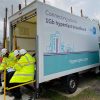BT See £712m for BDUK as Ultrafast Broadband Hits 2Million Premises
BT Group has released their latest results to the end of September 2018 (Q2 – 18/19 financial), which reveals that the coverage of Openreach’s “ultrafast broadband” (100Mbps+) G.fast network has reached 1290000 UK premises and FTTP covers 682,000 (13,000+ to “full fibre” per week). Plus there’s £712m to boost “fibre” cover.
As usual there have been a number of developments over the past few months, including Openreach’s decision to scale back their roll-out of hybrid fibre G.fast technology from 10 million to 5.7 million UK premises by the end of 2020 (here) and new areas were added to their Fibre-to-the-Premises (FTTP) rollout (here). Separately BT plans to hire another 1,000 customer service staff to improve support (here) and have a new CEO (here).
Meanwhile Openreach has further reduced the price of deploying FTTP for smaller new build home developments (here) and EE recently switched on their first live UK trial of 5G based wireless technology in London (here). EE are also said to be talking about the launch of a new Pay TV product based around the Apple TV 4K set-top-box (here).
Advertisement
The operator has however experienced a little turbulence in Scotland, where they’ve allegedly faced claims of anti-competitive behaviour by one of their rivals (Axione) in the country’s future R100 broadband contract (here). Despite all that the last quarter hasn’t been terribly eventful, at least in comparison to the turbulent period that came before.
Financial Highlights – BT’s Quarterly Change
* BT Group revenue = £5,908m (up from £5,716m)
* BT Group reported profits before tax = £841m (up from £816m)
* BT Group total net debt = -£11,895m (up from -£11,227m)
It’s worth remembering that since the last quarter BT has stopped providing customer figures for their consumer broadband ISP and mobile network, which followed a number of quarterly declines. As such our summary now focuses more on Openreach’s network than the subscriber data of their retail ISP. However it’s noted that 68.4% of BT’s retail broadband ISP base now takes a “superfast broadband” connection (up from 65.6% last quarter), which includes FTTC, FTTP and G.fast combined.
Interestingly though there’s a very important update on their capital expenditure and clawback / gainshare from the government’s Broadband Delivery UK roll-out programme with BT. More take-up in BDUK’s intervention areas means more public investment that can be returned and reinvested by local authorities further down the road to improve “superfast broadband” coverage toward 98% of the UK by 2020 (example).
The good news is that BT have revised their take-up assumptions in BDUK areas from 41% to 61%! In short, this means that up to around £712 million could in theory become available to be returned and reinvested into boosting coverage. This reflects a “life-time view” of the related contracts. We can still recall a time when some very pessimistic early estimates were expecting significantly lower take-up.
Advertisement
BT’s Capex for BDUK
Under the terms of the BDUK programme, we have an obligation to repay or re-invest grant funding depending on factors including the level of customer take-up achieved. Following sign up of the majority of its major and a number of its smaller communications providers to Openreach’s pricing discounts for volume commitments in the quarter, we have reassessed our base-case assumption for take-up in BDUK areas.
Based on the greater certainty provided by the volume commitments we have increased the take-up assumption from 41% to 61% of total premises passed, reflecting a life-time view of the BDUK programme. The gainshare provision increased by £176m in the half year to £712m, primarily driven by the take-up assumption change.
Openreach’s Network Coverage
One good thing about BT’s new reporting format is that they now offer a very useful breakdown of fixed line network coverage and take-up by technology. Being Openreach the totals given below apply to all ISPs on their national UK network combined (e.g. BT, Sky Broadband, TalkTalk, Vodafone etc.).

Take-up of their “full fibre” FTTP network seems to be going well, although it’s interesting to note that G.fast is lagging far behind on just 7,000 connections out of 1.3 million premises passed. In fairness Openreach’s FTTP network and ISPs have been established for significantly longer than G.fast. The latter has only seen ISPs begin to launch related packages since the late spring (2018), which follows a long pilot.
We’d expect to see a bigger movement toward G.fast as the coverage improves and major ISPs like Sky Broadband begin to offer related packages. But until then we remain impressed with how well FTTP is doing on the demand side, even if it has been established for longer and is arguably now more familiar to consumers than G.fast.
Advertisement
Gavin Patterson, Outgoing CEO of BT Group, said:
“We continued to generate positive momentum in the second quarter resulting in encouraging results for the half year. We are successfully delivering against the core pillars of our strategy with improved customer experience metrics, accelerating ultrafast deployment and positive progress towards transforming our operating model.
In Consumer, we continue to see strong sales of our converged product, BT Plus, and have seen good mobile sales following new handset launches. Last month EE demonstrated 5G capability from a live site in Canary Wharf. We have maintained momentum in our enterprise businesses despite legacy product declines.
On 1 October we completed the transfer of 31,000 employees into Openreach, a key part of fulfilling our DCR commitments. Openreach has signed up the majority of its major and a number of its smaller communications providers to its new volume related discounts which should increase average broadband speeds across the UK. We are making positive progress on the key enablers to ensure that we can secure a fair return on our FTTP investment, and are ready to expand the FTTP programme up to and beyond 10 million premises if the conditions are right.
Our strategy is delivering, with benefits evident from the steps we’ve been taking to simplify and strengthen the business and improve efficiency. Despite increasingly competitive fixed, mobile and networking markets and continued declines in legacy products there is no change in our overall outlook for the full year. Based on current trading, we expect EBITDA to be in the upper half of our £7.3 – £7.4 billion range.”
Sadly BT’s report didn’t include any updated figures for EE’s 4G network coverage, which perhaps stems from last quarter’s mistake of publishing a population coverage figure instead of a geographic one (i.e. EE weren’t happy about this as it went against their “Clear on coverage” pledge). Meanwhile Openreach said their FTTC, FTTP and G.fast based “fibre” networks now cover a total of 27,220,000 UK premises.
The network access operator also claims to have “delivered a record service performance” for voice and broadband products in Q2. “We were able to offer a provision first appointment date within 12 days to over 99% of customers, a significant improvement from 85% in Q2 2017/18, whilst missed appointments, where Openreach was at fault, was at an all-time low of 1.7% over the quarter. We remain ahead on all 42 copper and fibre Minimum Service Level (MSL) measures set by Ofcom.”
Openreach has had a good quarter for Ethernet delivery too, not least by reducing the average time to provide service from 43 working days to 34 in the same period.
Mark is a professional technology writer, IT consultant and computer engineer from Dorset (England), he also founded ISPreview in 1999 and enjoys analysing the latest telecoms and broadband developments. Find me on X (Twitter), Mastodon, Facebook, BlueSky, Threads.net and Linkedin.
« New UK Regulatory Regime Begins for Legally Separate Openreach
Vodafone UK Shaves £1 Off Superfast Home Broadband Prices »


















































Comments are closed